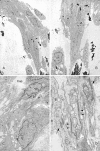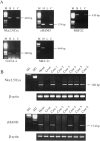Cardiomyogenic differentiation in cardiac myxoma expressing lineage-specific transcription factors
- PMID: 12163362
- PMCID: PMC1850740
- DOI: 10.1016/S0002-9440(10)64193-4
Cardiomyogenic differentiation in cardiac myxoma expressing lineage-specific transcription factors
Abstract
We investigated five cases of cardiac myxoma and one case of cardiac undifferentiated sarcoma by light and electron microscopy, in situ hybridization, immunohistochemical staining, and reverse transcriptase-polymerase chain reaction for cardiomyocyte-specific transcription factors, Nkx2.5/Csx, GATA-4, MEF2, and eHAND. Conventional light microscopy revealed that cardiac myxoma and sarcoma cells presented variable cellular arrangements and different histological characteristics. Ultrastructurally, some of the myxoma cells exhibited endothelium-like or immature mesenchymal cell differentiation. Immunohistochemistry for Nkx2.5/Csx, GATA-4, and eHAND was slightly to intensely positive in all myxoma cases. MEF2 immunoreactivity was observed in all cases including the case of sarcoma, thus suggesting myogenic differentiation of myxoma or sarcoma cells. In situ hybridization for Nkx2.5/Csx also revealed that all myxoma cells, but not sarcoma cells, expressed mRNA of the cardiac homeobox gene, Nkx2.5/Csx. Furthermore, nested reverse transcriptase-polymerase chain reaction from formalin-fixed, paraffin-embedded tissue was performed and demonstrated that the Nkx2.5/Csx and eHAND gene product to be detected in all cases, and in three of six cases, respectively. In conclusion, cardiac myxoma cells were found to express various amounts of cardiomyocyte-specific transcription factor gene products at the mRNA and protein levels, thus suggesting cardiomyogenic differentiation. These results support the concept that cardiac myxoma might arise from mesenchymal cardiomyocyte progenitor cells.
Figures



References
-
- Reynen K: Cardiac myxomas. N Engl J Med 1995, 333:1610-1617 - PubMed
-
- Burke AP, Virmani R: Cardiac myxoma: a clinicopathologic study. Am J Clin Pathol 1993, 100:671-680 - PubMed
-
- Tanimura A, Kitazono M, Nagayama K, Tanaka S, Kosuga K: Cardiac myxoma: morphologic, histochemical, and tissue culture studies. Hum Pathol 1988, 19:316-322 - PubMed
-
- Deshpande A, Venugopal P, Kumar AS, Chopra P: Phenotypic characterization of cellular component of cardiac myxoma. Hum Pathol 1996, 27:1056-1059 - PubMed
Publication types
MeSH terms
Substances
LinkOut - more resources
Full Text Sources
Medical
Research Materials

